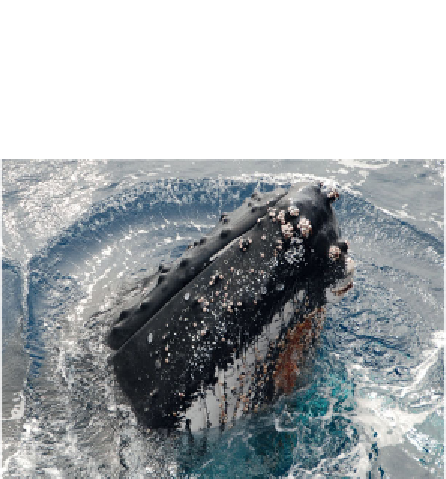Geoscience Reference
In-Depth Information
Figure 6.10
Humpback whale. Once heavily
fished, populations in the Southern Ocean are
slowly recovering. (Credit: Angelika Brandt)
suggest that their numbers are relatively stable and their abundance is probably in
the order of 10million animals, somewhat lower than earlier estimates. Thus it
seems unlikely that crabeater seals have increased greatly in numbers in response
to an increase in food supply caused by the demise of the great whales.
Whales
Historically the most important higher order predators in the Southern Ocean
have been the great whales. Whilst in the mind of the public the Antarctic is
generally associated with whales, most species are only there in the summer,
migrating south in October/November to graze on krill and phytoplankton as
the sea ice melts. Southern Ocean whales can be divided into those that feed
predominantly on krill (blue,
fin, humpback and minke), those that feed on other
small pelagic species such as copepods (right whale), and the toothed sperm whales
that are squid and
fish eaters. Killer whales are also important predators of other
whales, seals and penguins. Most of the krill-feeding whales are thought to migrate
north in autumn to breed in subtropical or tropical waters. There is, however,
some evidence that minke whales may remain in the pack ice zone throughout the
year, and recent research, using acoustic recording devices which locate whales by
their songs, has revealed that a proportion of the populations of other great whales
may also remain longer in Antarctic waters than was
rst thought.
There appears to be some segregation of the oceanic habitat by the baleen
whales, with the minkes being most associated with the sea ice, while blue and
humpback whales are mostly found offshore of the ice edge, and
fin whales farther
offshore still. This separation means that these four species are thought to consume
different size classes or species of krill, which also exhibit a degree of spatial
segregation with ice krill being found inshore or in the deep bays, juvenile



Search WWH ::

Custom Search